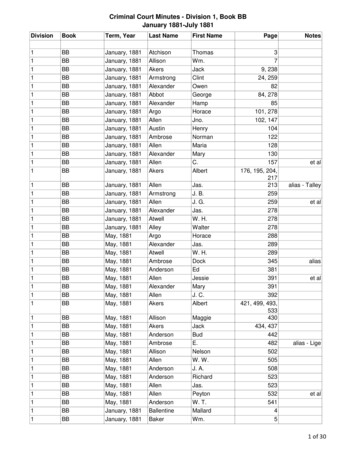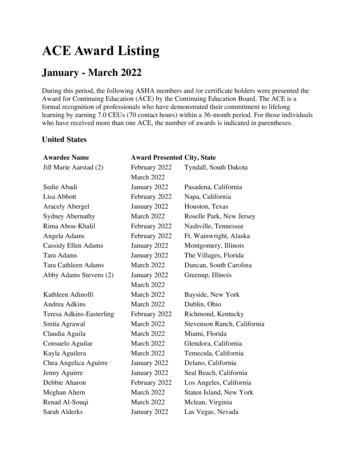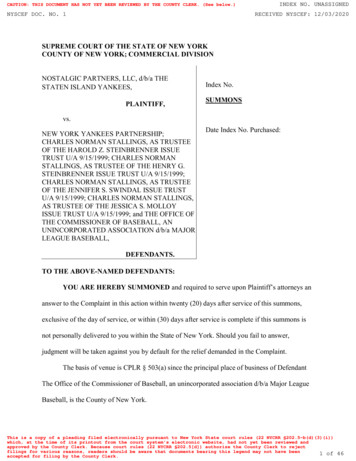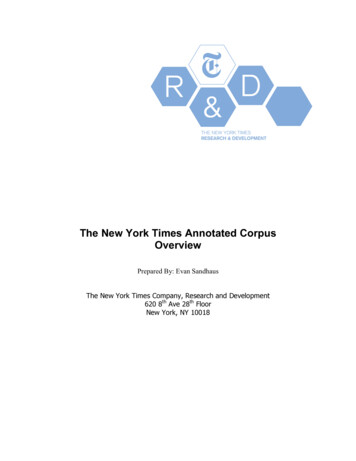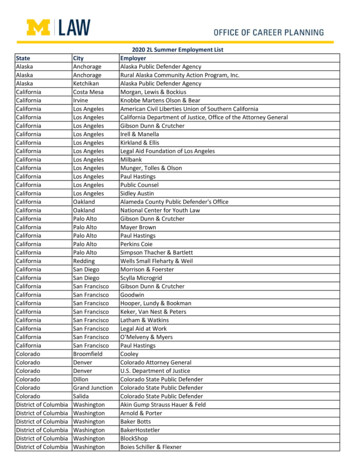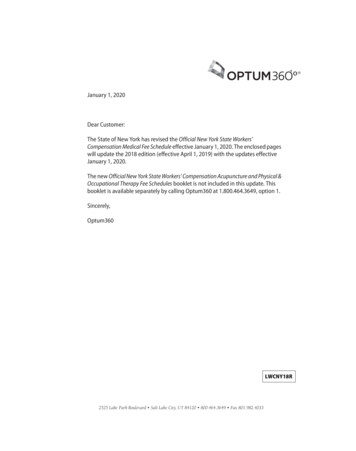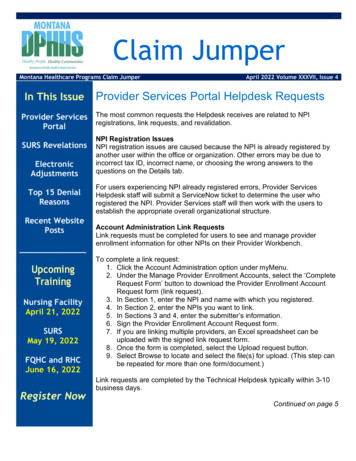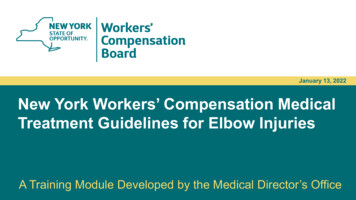
Transcription
January 13, 2022New York Workers’ Compensation MedicalTreatment Guidelines for Elbow InjuriesA Training Module Developed by the Medical Director’s Office
Elbow Training Module2 Medical Care2 Medical care and treatment required as a result of a work-related injuryshould be focused on restoring the patient’s functional ability to perform theirdaily and work activities with a focus on return to work, while striving torestore the patient’s health to its pre-injury status in so far as is feasible. Any medical provider rendering services to a workers’ compensation patientmust utilize the Workers’ Compensation Board’s New York MedicalTreatment Guidelines (MTGs) as provided for with respect to all work-relatedinjuries and/or illnesses.
Elbow Training Module3 Positive results are defined primarily as functional gains that can beobjectively measured. Objective functional gains include, but are not limited to,positional tolerances, range of motion, strength, endurance, activities of dailyliving (ADL), cognition, psychological behavior, and efficiency/velocitymeasures that can be quantified. Subjective reports of pain and function maybe considered and given relative weight when the pain has anatomic andphysiologic correlation in proportion to the injury.3
Elbow Training Module If a given treatment or modality is not producing positive results within awell-defined time frame, the provider should either modify or discontinuethe treatment regime. The provider should evaluate the efficacy of thetreatment or modality two to three weeks after the initial visit and threeto four weeks thereafter. These time frames may be slightly longer in thecontext of conditions that are inherently mental health issues, andshorter for other non-musculoskeletal medical conditions (e.g.,pulmonary, dermatologic etc.). Recognition that treatment failure is attimes attributable to an incorrect diagnosis, a failure to respond shouldprompt the clinician to reconsider the diagnosis in the event of anunexpected poor response to an otherwise rational intervention.44
Elbow Training Module 55Education of the patient and family, as well as the employer, insurer, policymakers and the community, should be a primary emphasis in the treatment ofa work-related injury or illness. Practitioners should develop and implementeffective educational strategies and skills. An education-based paradigmshould always start with communication providing reassuring information tothe patient. No treatment plan is complete without addressing issues ofindividual and/or group patient education as a means of facilitating selfmanagement of symptoms and prevention of future injury.
Elbow Training Module Acuity 6Acute, subacute and chronic are generally defined as time frames fordisease stages: Acute – Less than one month Subacute – One to three months, and Chronic – Longer than three months6
Elbow Training Module7 Time Frames7 Diagnostic time frames for conducting diagnostic testing commence on thedate of injury. Treatment time frames for specific interventions commence oncetreatments have been initiated, not on the date of injury. Clinical judgment may substantiate the need to accelerate or decelerate thetime frames discussed in this training module. Specific durations of treatments and number of treatment visits (e.g.,physical therapy/occupational therapy (PT/OT)) are beyond the scope ofthis training module and the provider should refer to the recommendationsin the MTGs.
Elbow Training Module8 Delayed Recovery 8For those patients who fail to make expected progress 6-12 weeks after aninjury and whose subjective symptoms do not correlate with objective signsand tests, reexamination in order to confirm the accuracy of the diagnosisand reevaluation of the treatment program should be performed. Whenaddressing a clinical issue that is not inherently a mental health issue,assessment for potential barriers to recovery (yellow flags/psychologicalissues) should be ongoing throughout the care of the patient. At 6-12weeks, alternate treatment programs, including formal psychological orpsychosocial evaluation should be considered. Clinicians must be vigilantfor any pre-existing mental health issues or subsequent, consequentialmental health issues that may be impacting recovery.
Elbow Training Module9 Delayed Recovery 9For issues that are clearly and inherently mental health issues from theoutset (i.e., when it is evident that there is an underlying, work-related,mental health disorder as part of the claim at issue), referral to a mentalhealth provider can and should occur much sooner. Referrals to mentalhealth providers for the evaluation and management of delayed recovery donot indicate or require the establishment of a psychiatric or psychologicalcondition. The evaluation and management of delayed recovery does notrequire the establishment of a psychiatric or psychological claim.
Elbow Training Module10 Active Interventions 10Active interventions emphasizing patient responsibility, such as therapeuticexercise and/or functional treatment, are generally emphasized over passivemodalities, especially as treatment progresses. Generally, passive andpalliative interventions are viewed as a means to facilitate progress in anactive rehabilitation program with concomitant attainment of objectivefunctional gains.
Elbow Training Module11 Diagnostic Imaging and Testing Procedures11 Clinical information obtained by history taking and physical examinationshould be the basis for selection of imaging procedures and interpretationof results. It may be of value to repeat diagnostic procedures (e.g., imaging studies)during the course of care to reassess or stage the pathology when there isprogression of symptoms or findings, prior to surgical interventions andtherapeutic injections when clinically indicated, and post-operatively tofollow the healing process.
Elbow Training Module Surgical Interventions 12Consideration of surgery should be within the context of expectedfunctional outcome. The concept of "cure" with respect to surgicaltreatment by itself is generally a misnomer. All operative interventionsmust be based upon positive correlation of clinical findings, clinicalcourse, imaging, and other diagnostic tests.12
Elbow Training Module13 Surgical Interventions 13For surgery to be performed to treat pain, there must be clear correlationbetween the pain symptoms and objective evidence of its cause. In allcases, shared decision making with the patient is advised.
Elbow Training Module14 Pre-Authorization 14All diagnostic imaging, testing procedures, non-surgical and surgicaltherapeutic procedures within the criteria of the MTGs and based on acorrect application of the MTGs are considered authorized, with theexception of the procedures listed in section 324.3(1)(a) of Title 12 NYCRR.
Elbow Training Module15 Pre-Authorization 15Second or subsequent procedures (the repeat performance of a surgicalprocedure due to failure of, or incomplete success from, the same surgicalprocedure performed earlier, if the MTGs do not specifically addressmultiple procedures) also require pre-authorization.
Elbow Training Module16 Personality/Psychological/Psychosocial Evaluations 16In select patients, mental health evaluations are essential to make, secureor confirm a diagnosis. Of course, the extent and duration of evaluationsand/or interventions by mental health professionals may vary, particularlybased on whether: the underlying clinical issue in the claim is inherently amental health issue; there is a mental health issue that is secondary orconsequential to the medical injury or illness that is at issue in the claim inquestion; or there is a pre-existing, unrelated mental health issue that hasbeen made worse by, and/or is impeding the recovery from the medicalinjury or illness that is at issue in the claim in question.
Elbow Training Module17 Personality/Psychological/Psychosocial Evaluations17 When assessing for a pre-existing, unrelated mental health issue that hasbeen made worse by and/or is impeding the recovery from a work-related,medical injury or illness, then a one-time visit for initialpsychiatric/psychological encounter should be sufficient, as care wouldnormally be continued by the prior treating provider. If psychometric testing is indicated by findings in the initial encounter, timefor such testing should not exceed an additional three hours of professionaltime.
Elbow Training Module18 Personality/Psychological/Psychosocial Evaluations 18For conditions in which a mental health issue is a central part of the initialclaim, or in which there is a mental health issue that is secondary orconsequential to the work-related, medical injury or illness, that is part ofthe claim in question, then more extensive diagnostic and therapeuticinterventions may be clinically indicated and are discussed in detail in theMTGs for such mental health conditions.
Elbow Training Module19 Functional Capacity Evaluation (FCE) Functional capacity evaluation is a comprehensive or more restrictedevaluation of the various aspects of function as they relate to the patient’sability to return to work. 19In most cases, the question of whether a patient can return to work can beanswered without an FCE.An FCE may be considered at time of maximum medical improvement(MMI), following reasonable prior attempts to return to full duty throughoutcourse of treatment, when the treating physician is unable to make a cleardetermination on work status on case closure. An FCE is not indicated earlyduring a treatment regime for any reason including one to support atherapeutic plan.
Elbow Training Module20 Functional Capacity Evaluation (FCE) 20When an FCE is being used to determine return to a specific job site, thetreating provider is responsible for understanding and considering the jobduties. FCEs cannot be used in isolation to determine work restrictions. Theauthorized treating provider must interpret the FCE in light of the individualpatient's presentation and medical and personal perceptions. FCEs shouldnot be used as the sole criteria to diagnose malingering.
Elbow Training Module21 Functional Capacity Evaluation (FCE) 21An FCE may be considered at time of MMI, following reasonable priorattempts to return to full duty throughout the course of treatment, when thetreating provider is unable to make a clear determination on work status oncase closure.
Elbow Training Module22 Return To Work 22For purposes of the MTGs, return to work is defined as any work or dutythat the patient is able to perform safely. It may not be the patient’s regularwork. Ascertaining a return-to-work status is part of medical care andshould be included in the treatment and rehabilitation plan. It is normallyaddressed at every outpatient visit.
Elbow Training Module23 Return To Work 23A description of the patient’s status and task limitations is part of anytreatment plan and should provide the basis for restriction of work activitieswhen warranted. Early return to work should be a prime goal in treatingoccupational injuries. The emphasis within the MTGs is to move patientsalong a continuum of care and return to work, since the likelihood ofreturning an injured worker to work drops progressively the longer theworker has been out of work.
Elbow Training Module Return To Work 24When returning to work at the patient’s previous job task/setting is notfeasible given the clinically determined restrictions on the patient’sactivities, inquiry should be made about modified duty work settings.24
Elbow Training Module25 The NY WC MTG for Elbow Injuries address common and potentially workrelated elbow injuries. It encompasses assessment (including identification of“red flags” or indicators of potentially-serious injury or disease); diagnosis;diagnostic studies for identification of clinical pathology; work-relatedness;and management, including modified duty and activity, return to work, and anapproach to delayed recovery. 25Red flags include fracture, dislocation, infection, inflammation and otherconditions.
Elbow Training Module26 History Taking and Physical Examination 26History taking and physical examination establish the foundation/basis for anddictate subsequent stages of diagnostic and therapeutic procedures. Whenfindings of clinical evaluations and those of other diagnostic procedures are notconsistent with each other, the objective clinical findings should havepreference.
Elbow Training Module27 History of Present Injury Mechanism of injury: Details of symptom onset and progression, andsymptoms that may arise from postural or functional accommodation to theelbow injury; Relationship to work: Statement of the probability that the illness or injury iswork-related; Prior injuries: Previous occupational and non-occupational injuries to thesame area including specific prior treatment; Functional abilities: Ability to perform job duties and activities of daily living;and Additional factors: Exacerbating and alleviating factors for symptoms.27
Elbow Training Module28 Past History28 Past medical history includes, but is not limited to, neoplasm, gout, arthritis,and diabetes; Review of systems includes, but is not limited to, symptoms of rheumatologic,neurologic, endocrine, neoplastic, and other systemic diseases; Smoking history; Vocational and recreational pursuits; Prior imaging studies; and Past surgical history.
Elbow Training Module29 Physical Examination Examination of a joint should include the joint above and below the affectedarea, including the opposite side for comparison. Physical examination shouldinclude accepted tests and exam techniques applicable to the joint or areabeing examined, including: 29Visual inspection; palpation; bilateral range of motion (active/passive); strength;joint stability; neurologic assessment.
Elbow Training Module30 Assessing Red Flags 30Certain findings raise red flags—suspicions of potentially serious medicalconditions. In the elbow, these findings or indicators may include: fracture,dislocation, infection or inflammation, tumor, tendon rupture and neurologicalor vascular compromise including compartment syndrome. Furtherevaluation/consultation or urgent/emergency intervention may be indicated,and the NY WC MTG for Elbow Injuries incorporate changes in clinicalmanagement triggered by the presence of red flags.
Elbow Training Module31 Diagnostic Criteria and Differential Diagnosis 31For most cases presenting with true elbow disorders, diagnostic studies areusually not needed until after a period of conservative care and observation.Most elbow problems improve quickly once any red flags are ruled out. Routinetesting, i.e., laboratory tests, plain-film radiographs of the elbow, or specialimaging studies are not recommended during the first month of activitylimitation except when a red flag that is noted on history or examination raisessuspicion of a dangerous elbow condition or of referred pain.
Elbow Training Module32 Diagnostic Testing and Procedures 32One diagnostic imaging procedure may provide the same or distinctiveinformation as obtained by other procedures. Therefore, prudent choice ofprocedure(s) for a single diagnostic procedure, a complementary procedure incombination with other procedures(s), or a proper sequential order in multipleprocedures will ensure maximum diagnostic accuracy, minimize adverse effectto patients and promote cost effectiveness by avoiding duplication orredundancy.
Elbow Training Module33 Diagnostic Testing and Procedures 33It is recognized that repeat imaging studies and other tests may be warrantedby the clinical course and to follow the progress of treatment in some cases. Itmay be of value to repeat diagnostic procedures (e.g., imaging studies) duringthe course of care to reassess or stage the pathology when there isprogression of symptoms or findings, prior to surgical interventions andtherapeutic injections when warranted, and post-operatively to follow thehealing process.
Elbow Training Module34 Diagnostic Testing and Procedures It is recognized that repeat imaging studies and other tests may be warrantedby the clinical course and to follow the progress of treatment in some cases. Itmay be of value to repeat diagnostic procedures (e.g., imaging studies) duringthe course of care to: 34Reassess or stage the pathology when there is progression of symptoms orfindings,Prior to surgical interventions and therapeutic injections when warranted, andPost-operatively to follow the healing process.
Elbow Training Module35 Medications35 For most patients, generic ibuprofen, naproxen, or other older generationnonsteroidal anti-inflammatory drugs (NSAIDs) are recommended as first-linemedications. Second-line medications should include one of the other genericmedications. Acetaminophen (or the analog paracetamol) may be a reasonablealternative for these patients, although most evidence suggestsacetaminophen is modestly less effective. There is evidence that NSAIDs areas effective for relief of pain as opioids (and tramadol) and less impairing. See also: NY WC MTG for Non-Acute Pain
Elbow Training Module Medication General Guidelines NSAIDs for patients at high risk of gastrointestinal bleeding 36Recommended – Concomitant use of cytoprotective classes of drugs:misoprostol, sucralfate, histamine Type 2 receptor blockers, and proton pumpinhibitors for patients at high risk of gastrointestinal bleeding.At-risk patients include those with a history of prior gastrointestinal bleeding,elderly, diabetics, and cigarette smokers.36
Elbow Training Module37 Medication General Guidelines NSAIDs for patients at risk for cardiovascular adverse effects: 37Recommended – Acetaminophen or aspirin as the first-line therapy appear to bethe safest regarding cardiovascular adverse.Recommended – If needed, NSAIDs that are non-selective are preferred overCOX-2 specific drugs. In patients receiving low-dose aspirin for primary orsecondary cardiovascular disease prevention, to minimize the potential for theNSAID to counteract the beneficial effects of aspirin, the NSAID should be taken atleast 30 minutes after or eight hours before the daily aspirin.
Elbow Training Module Contusions 38A contusion is an injury of a part without a break in the skin and with asubcutaneous hemorrhage. It is an acute injury with bruising.38
Elbow Training Module Contusions Treatments 39Recommended – Ice, compression and range of motionNot Recommended – ImmobilizationRecommended – NSAIDS and acetaminophen39
Elbow Training Module40 Epicondylitis 40Lateral Epicondylitis (Tennis Elbow) causes soreness or pain on the outside ofthe upper arm near the elbow and is diagnosed based on a combination oflateral elbow pain plus tenderness to palpation. Most patients require nospecial testing provided red flags are absent.
Elbow Training Module41 Epicondylitis (Epicondylalgia)41 Medial Epicondylitis (Golfer’s Elbow) affects the medial or inner aspect of theelbow and is sometimes thought to occur concomitantly with ulnar neuropathyat the elbow. Treatment of Medial Epicondylitis is analogous to Lateral Epicondylitis.
Elbow Training Module42 Epicondylalgia Treatments 42Recommended – NSAIDs/APAP for pain.Recommended – Opioids for select post-operative Epicondylalgia patients for nomore than one week.Topical NSAIDs may be utilized for acute, chronic or post-operative Epicondylalgia.
Elbow Training Module43 Epicondylalgia Treatments 43Ice, heat, PT/OT‒ Not Recommended – Manipulation and mobilization, massage, magnets,extracorporeal shockwave, phonophoresis and low-level laser therapy,acupuncture for acute or post-operative patients, biofeedback.‒ Recommended – Elbow bands, straps and braces.‒ Recommended – For select, chronic patients, Iontophoresis, ultrasound,acupuncture for select chronic patients.
Elbow Training Module44 Epicondylalgia Treatments 44Injections‒ Recommended – In select patients, glucocorticosteroid and dry needling forsubacute or chronic epicondylalgia.‒ Recommended – Platelet rich plasma and autologous blood arerecommended for chronic lateral epicondylalgia.
Elbow Training Module Epicondylalgia Surgery 45Lateral Epicondylar Release‒ Recommended – For treatment of chronic epicondylalgia.45
Elbow Training Module46 Olecranon Bursitis 46Olecranon bursitis is a condition associated with a generally painless effusionof the olecranon bursa. Most patients are treated initially with soft elbowpadding, support or an ace wrap while avoiding elbow pressure. Septicolecranon bursitis is either a complication of aseptic olecranon bursitis or adirect consequence of trauma.
Elbow Training Module47 Olecranon BursitisDiagnostic studies 47There are no special studies for most cases of olecranon bursitis.Recommended – Fluid aspiration of swollen bursa if the bursa is thought to beinfected.Recommended – X-ray to rule out osteomyelitis or joint effusion in cases of significantseptic bursitis.
Elbow Training Module Olecranon Bursitis48 Recommended – NSAIDs/APAP for pain Not Recommended – Injection therapies48
Elbow Training Module49 Olecranon Bursitis Surgery 49Surgery has been widely used to treat olecranon bursitis that has not responded toactivity modifications and injections.Recommended – Surgical drainage for olecranon bursitis and surgical resectionfor chronic olecranon bursitis.
Elbow Training Module Elbow Fractures (including Non-Displaced RadialHead Fracture) 50Diagnostic Studies Elbow fractures most commonly occur from falls. Recommended – X-rays that include two to three views.50
Elbow Training Module Elbow Fractures (including Non-Displaced RadialHead Fracture) Medications 51Recommended – NSAIDs/APAP for pain.Recommended – Opioids for select patients with pain from fracture or in theimmediate post-operative period.51
Elbow Training Module52 Elbow Fractures (including Non-Displaced RadialHead Fracture) Treatment 52Recommended – Casts and cast bracing for select elbow fractures, elbow slingsfor non-displaced and occult radial head fractures.Recommended – PT/OT is after cast removal.
Elbow Training Module Elbow Fractures (including Non-Displaced RadialHead Fracture) Surgery 53Recommended – Surgical fixation of displaced elbow fractures53
Elbow Training Module54 Elbow Dislocations54 Dislocation of the elbow generally occurs as a result of significant, high forcetrauma and is diagnosed based on a combination of typical inciting eventcombined with deformity and inability to use the arm. Recommended – X-rays to rule out fractures. Recommended – General anesthesia to facilitate reduction in select patients.
Elbow Training Module55 Elbow Dislocations55 Pain medications including NSAIDs/APAP, as well as opioids may be required.Care should be taken to limit the duration of narcotic pain medications. Recommended – Anesthetic Intra-articular injections for pre or post reductionpain.
Elbow Training Module56 Elbow Dislocations Surgery 56Recommended – For elbow joints that recurrently dislocate or are unstable afterdislocation.Recommended – Posterior elbow splint and sling after reduction.
Elbow Training Module57 Elbow Sprains57 An isolated elbow sprain is relatively uncommon and is caused by a significanthigh-force trauma. Generally, a sprain is accompanied by other problems suchas fracture, dislocation, or contusion. Recommended – X-rays, at least two to three view to rule out fractures. Recommended – Slings
Elbow Training Module58 Elbow Sprains Medications 58Recommended – NSAIDs/APAP for pain.Recommended – Opioids for select patients with pain from sprain may be usedshort term, no longer than a week.
Elbow Training Module Elbow Sprains 59Recommended – Slings for elbow sprains.59
Elbow Training Module60 Biceps Tendinosis and Tears/Ruptures 60Biceps Tendinosis is a true muscle strain involving the muscle-tendon junctionof the biceps brachii. Patients with severe or complete ruptures should bereferred to a surgeon to evaluate the need for surgical repair. Other patientsshould receive treatment including activity limitations and pain managementstrategies generally centered on NSAIDS.
Elbow Training Module Biceps Tendinosis and Tears/Ruptures Diagnostic studies 61Recommended – X-rays, MRI, ultrasound.61
Elbow Training Module62 Biceps Tendinosis and Tears/Ruptures Medications 62Recommended – NSAIDs/APAP for pain.Recommended – Opioids for select patients with pain from moderate to severebiceps tendinosis or ruptures particularly with nocturnal sleep disruption, as well aspost-operatively. Opioids should be utilized for short duration only.
Elbow Training Module Biceps Tendinosis and Tears/Ruptures 63Recommended - Strengthening exercises, Slings and splints.63
Elbow Training Module Biceps Tendinosis and Tears/Ruptures Surgery 64Recommended – Surgical repair for distal biceps ruptures.64
Elbow Training Module65 Triceps Tendinosis (or Tendinitis) and Tears/Ruptures65 Triceps tendinosis (or tendinitis) is a true muscle strain involving the muscletendon junction of the triceps. It is believed to be analogous to biceps tendinosis,including high force mechanism of injury. Triceps ruptures often require surgical repair.
Elbow Training Module66 Ulnar Neuropathies at the Elbow (including CondylarGroove Associated Ulnar Neuropathy and CubitalTunnel Syndrome) 66There are two common areas for entrapment of the ulnar nerve at the elbow,the condylar groove and immediately distal to the elbow joint in the cubitaltunnel.
Elbow Training Module67 Ulnar Neuropathies at the Elbow (including CondylarGroove Associated Ulnar Neuropathy and CubitalTunnel Syndrome)67 Initial care involves seeking potential causal factors that can be changed. Recommended – That patients be taught to sleep with their elbows extendedrather then flexed and to avoid hyper-flexed elbow postures at work.
Elbow Training Module68 Ulnar Neuropathies at the Elbow (including CondylarGroove Associated Ulnar Neuropathy and CubitalTunnel Syndrome)68 Diagnostic studies Recommended – Electromyogram/Nerve Conduction Study (EMG/NCS) indiagnosis and or preoperative assessment of ulnar neuropathies at the elbow. Not Recommended – Electrodiagnostic Studies (EDS) for initial evaluation,diagnostic ultrasound and MRI.
Elbow Training Module69 Ulnar Neuropathies at the Elbow (including CondylarGroove Associated Ulnar Neuropathy and CubitalTunnel Syndrome) Medications 69Recommended – NSAIDs/APAP for pain.Recommended – Opioids for select post-operative patients.Not Recommended – Routine use of opioids for acute, subacute or chronicneuropathies.Not Recommended – Injections.
Elbow Training Module70 Ulnar Neuropathies at the Elbow (including CondylarGroove Associated Ulnar Neuropathy and CubitalTunnel Syndrome) Treatments 70Recommended – PT/OT, elbow and wrist splinting, ultrasound.Not Recommended – Magnets, acupuncture, biofeedback, manipulation andmobilization, massage, iontophoresis, phonophoresis, low-level laser therapy.
Elbow Training Module71 Ulnar Neuropathies at the Elbow (including CondylarGroove Associated Ulnar Neuropathy and CubitalTunnel Syndrome) 71Surgery – Surgical release for treatment of subacute or chronic ulnarneuropathies (decompression, anterior subcutaneous transposition and medialepicondylectomy). Recommended – For patients who fail non-operative treatment for subacute orchronic ulnar neuropathies or patients who have emergent or urgent indications (e.g.,acute compression due to fracture, arthritides or compartment syndrome withunrelenting symptoms of nerve impairment). Not Recommended – Anterior submuscular transposition for the treatment ofsubacute or chronic ulnar neuropathies.
Elbow Training Module72 Radial Nerve Entrapment (including Radial TunnelSyndrome) Radial nerve entrapment, particularly of the posterior interosseous branch ofthe radial nerve, causes proximal forearm aching and pain that persists despitepresumably effective treatment. In the absence of quality evidence for treatment of these radiculopathies, it isrecommended that treatments for ulnar neuropathy at the elbow be followed.72
Elbow Training Module Radial Nerve Entrapment (including Radial TunnelSyndrome) Medications 73Recommended – NSAIDs/APAP for pain.Recommended – Opioids for select post-operative patients.Not Recommended – Glucocorticosteroids, vitamins, lidocaine patches andopiates for acute, subacute, or chronic radial nerve entrapment pain.73
Elbow Training Module74 Radial Nerve Entrapment (including Radial TunnelSyndrome) Treatments 74Recommended – PT/OT, elbow and wrist splinting, ultrasound.Not Recommended – Magnets, acupuncture, biofeedback, manipulation andmobilization, massage, soft tissue massage, iontophoresis, phonophoresis, lowlevel laser therapy.
Elbow Training Module Radial Nerve Entrapment (including Radial TunnelSyndrome) Surgery 75Recommended – Surgical release for treatment of subacute or chronic ulnarneuropathies.75
Elbow Training Module76 Pronator Syndrome (Median Neuropathies in theForearm)76 Pronator Syndrome involves median nerve entrapment under or within thepronator teres muscle in the proximal forearm. It causes pain in the flexorforearm and paresthesia similar to Carpal Tunnel Syndrome (CTS), which isthe main consideration in the differential diagnosis. Recommended – Pronator Syndrome electrodiagnostic study for confirmationof Pronator Syndrome.
Elbow Training Module Pronator Syndrome (Median Neuropathies in theForearm) Medications 77Recommended – NSAIDs/APAP for pain.Recommended – Opioids for select post-operative patients.Not Recommended – Glucocorticosterioids, vitamins, lidocaine patches
Elbow Training Module History of Present Injury Mechanism of injury: Details of symptom onset and progression, and symptoms that may arise from postural or functional accommodation to the elbow injury; Relationship to work: Statement of the probability that the illness or injury is work-related; Prior injuries:

